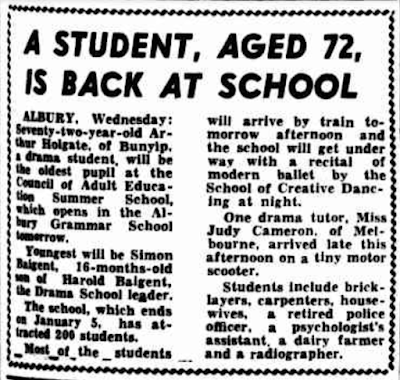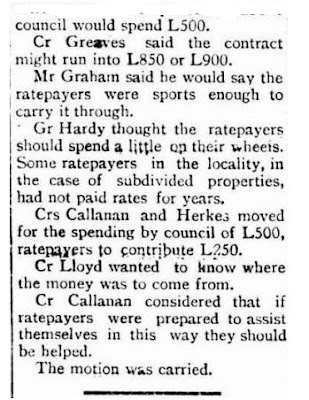Banking in Koo Wee Rup started in 1905 when an agency of the London Bank at Garfield was established in the town. In 1920, the London Bank amalgamated with the English, Scottish & Australian Bank (E.S. & A Bank) who in turn amalgamated with the ANZ in 1970.
The London Bank establishes an agency in Koo Wee Rup.
The Garfield
agency of the London Bank was established in July 1904 and it was converted to a full Branch a year later, with the first manager being Clarence Adeney. So successful was the Garfield Branch that the Koo Wee Rup agency was established in August 1905 and the next year agencies at Yannathan, Iona and Tynong. By September 1906, the Koo Wee Rup agency was also successful enough to be converted into a full Branch, and the Garfield manager, Clarence Adeney, was placed in charge where he remained until 1920. (1) A Branch, as opposed to an Agency, had full-time operating hours and its own manager.
Also in 1906, Banking Chambers were constructed, as the Lang Lang Guardian reported in September -
Mr A. Woodman had accepted a contract from the London Bank of Australia Ltd to erect a
Bank chambers and Dwelling at an estimated cost of £600. The construction is to be of oregon and plaster and it is also proposed to use tiles for the
roof. (2)
Another report of the new building was in the South Bourke & Mornington Journal -
The authorities of the London Bank Australia have decided to erect a bank here, and to that end plans and specifications have been prepared by a Melbourne firm of architects. It is estimated that the structure will cost between £600 and £700, and will be an undoubted acquisition to the district. (3)
In October 1912, the London Bank purchased the site of their building for a satisfactory price as noted by the South Bourke & Mornington
Journal. (4)
On October 22, 1917, around 10.00 am there was a tragic accident at the branch when 25 year-old William Lees McClure, the Bank clerk at Koo Wee Rup was shot. The Bank's loaded revolver had been on the counter, William removed it from the counter and placed it on a stool and when opening the cash drawer had accidently knocked the gun off the stool, it hit the ground and exploded, and a bullet entered his groin. He was taken to Nurse Campbell's Private Hospital in Dandenong, operated on, however the wound became septic and he died on November 6. Evidence was given at the Inquest by Mr Adeney, who said it was usual for me to place the automatic pistol on the counter, there was also another revolver for the use of the bank officials.
William, was the son of William Lees McClure and his wife Catherine (nee Hallinan) of Clericote, Tootal Road, Springvale, he had a sister Florrie and a brother Tom. William was buried at the Cheltenham Pioneer Cemetery. The Inquest determined the incident was an accident. It was a senseless death and as William's father noted in his evidence - My son left my home at Springvale at 6.45 am in good health and spirits, and he had no financial or other troubles.(5)
In 1919, the original building was expanded, by building out to the footpath and adding a second storey and in October 1919 the Koo Wee Rup Sun reported that -
The contractor for the alterations to the London Bank at Koo-Wee-Rup has the work well in hand and will complete it in a few weeks. It speaks well for Koo-Wee-Rup when the local bank has to enlarge its premises. The extra room will be needed in anticipation for the next record season.
(6)
E.S. & A. Bank in Station Street, Koo Wee Rup c. 1920s
In December, the Koo Wee Rup Sun could report on the finished building -
Bank Improvements
Another exemplification as to the soundness of this district has been shown by the London Bank of Australia, for this financial Institution has had big alterations carried out in their Kooweerup premises, and tenders were recently called for the erection of another building at Dalmore. For some time past the officials have been hampered in their work by the want of more room, and this, coupled with the fact that no banking company indulges in any expenditure unless fully assured that the possibilities ahead are of the best, it is a good guarantee as to the potentialities of the swamp area.
The alterations carried out consist of more room being made for the conduct of general business, a manager's office, and rooms upstairs to be used as residential quarters. The work has taken longer to carry out, than anticipated, owing to labour troubles, strikes and railway delay, but despite all these inconveniences the contractor has performed his task in a quick and thorough manner, and has earned the appreciation of the authorities in Melbourne.
The ceilings are made of picton fibre panels and moulded, and the plastering of the walls have been neatly done. New office fittings have been provided, the timber used being Queensland maple, nicely finished with french polish. A new strong room has also been erected and the building renovated throughout. (7)
The architects for the renovations were Oakden, Ballantyne and Hare.
Oakden, Ballantyne and Hare, call for tenders for the alterations to the Koo Wee Rup Bank.
E.S. & A. Bank in Station Street, Koo Wee Rup c. 1940s
During all this time Clarence Adeney was the manager. Described in one report as the genial Mr Adeney and described by David Mickle as a kind and gentle man, he left the managers position at Koo Wee Rup in early 1920 and was replaced by William Kerr Paterson, whose wife Margaret was to become the inaugural President of the Koo Wee Rup CWA when it was established in 1929. (8). Clarence then took up the part-time position operating the Yannathan bank.
In January 1923 The Argus reported that -
Mr. C. Adeney, J.P., of Yannathan, has been granted extended, leave of absence from the E. S. and A. Bank on account of ill health. During the last 22 years Mr. Adeney managed a number of branches of the London Bank (now the English, Scottish, and Australian Bank). He has been intimately associated with the development of the closer settlement areas, more particularly the Koo-wee-rup swamp. (8)
Clarence Adeney was born in 1869 to Henry William Howells Adeney and his wife Sarah (nee Pitman). His father was an Anglican Minister and his mother, as a matter of interest, was the niece of Sir Isaac Pitman, who invented Pitman shorthand system. Clarence married Angelina Treweek in 1895 and they had four children - Arnold (1901 in Maryborough), Henry Allen (1903 Warragul ), Dorothy (1905 Warragul), Marjorie (1906 Garfield). Clarence died aged 79 on July 10, 1948; a year after Angelina who died July 24, 1947 (9)

The Lang Lang E.S. & A Bank
The
Cardinia Shire Heritage Study (10) describes the Koo Wee Rup Bank as an early example of the
architectural style known as towards modernism and it is one of three former
E.S. & A Banks in the Heritage Study. The other ones are the Garfield Bank,
which was built in 1931 (11) and the Lang Lang Bank, which was built in 1929. The
Garfield Bank is thought to have been designed by Twentyman & Askew, the
same Architects as the Lang Lang bank. (12)
The ANZ closed the Koo Wee Rup Bank on May 11, 2016, and the building is currently occupied by a Pharmacy. (13)
Trove list - I have created a list of articles on the Koo Wee Rup Bank of London / E.S. & A/ANZ Bank (and the Garfield Banks of the same names), access it
here.
Footnotes
(2) Lang Lang Guardian, September 5, 1906, p. 2.
(3)
South Bourke & Mornington Journal, September 12, 1906, see
here.
(4)
South Bourke & Mornington Journal, October 10, 1912, see
here.
(6)
Koo Wee Rup Sun, October 1, 1919, p. 5;
South Bourke & Mornington Journal, October 16, 1919, see
here.
(7) Koo Wee Rup Sun, December 24, 1919, p. 6
(9) Indexes to the Victorian Births, Deaths and Marriages; family notices in my Trove list; article on the Reverend Adeney,
The Herald, June 30, 1928, see
here(10) Cardinia Local Heritage Study Review 2008 - Volume 5: Stage B Individual places, Draft June 2008, Context P/L., p. 173-177 of 304.
(12) Cardinia Shire Heritage Study; a Heritage Study of parts of the Shire previously in the Cranbourne and Sherbrooke Shires - Volume 2: Heritage Places - by Graeme Butler & Associates (Cardinia Shire, 1999), pp. 159-160.
(13) I originally wrote this in April 2016 and started it with -
The ANZ Bank in Rossiter Road is closing down in the next few weeks (May 2016) so this is a look at the early history of the bank in Koo Wee Rup. It was revised in June 2024.
Report from the Pakenham Gazette of 21/3/2016 by Russell Bennett
Bank pulls out of Kooweerup.
THE ANZ Bank will withdraw from the Kooweerup community in May, with the local branch closing its doors.
In a statement issued to the Gazette, an ANZ spokesman said the decision to close was a difficult one and came about after a detailed review. The Kooweerup branch will be closed from 11 May.
“We apologise to our customers for any inconvenience this closure may cause,” the statement said.
“Our review showed customers in the area are using the Kooweerup branch less and less for their banking needs, while many customers are increasingly using alternatives such as our mobile phone banking app, ‘goMoney’, internet banking or ATMs.
“We have written to our customers to let them know about this closure and to let them know where and how they can continue to do their banking. They can visit us at our Pakenham branch, which is less than 16 kilometres away, and we are exploring whether we can keep an ANZ ATM in Kooweerup, either at the current location or elsewhere.
“Customers can also use the Bank@Post facilities located at 48 Station Street in Kooweerup – 110 metres away from the branch site – which will offer deposits, withdrawals and payments for customers using ANZ debit or credit cards. We also have phone and online banking services available to customers 24/7 which can be accessed by calling 13 13 14 or by visiting anz.com.”
Kooweerup Township Committee president Ray Brown said the bank had made a commercial decision.
“It’s certainly disappointing for the town but with the latest banking technology out there, it was probably inevitable,” he said.
“The town once had the State Savings Bank (now the Commonwealth), the National Bank and the ANZ but banking has been depleted over the years.”
Mr Brown said the lack of parking outside the town’s iconic ANZ branch building had become an issue over the years.
“The building is probably past its use-by date,” he said.
Mr Brown said he thought the ANZ branch’s closure was “inevitable”, but added: “It’s still taken a lot of people by surprise”.
He said the bank was entrenched in the town when he arrived in 1970 and was “part of the fabric of the community”.
“People who rely on the bank will certainly miss out,” he said.
“They’ll look elsewhere now.
“As a committee we’re going to write to the ANZ and express our concern over it (the move).”
But Mr Brown said he couldn’t argue with the economic reasoning behind the branch’s closure.
“If you don’t use it, you lose it,” he said.
“The ANZ bank has always provided great service from great people and it’ll be missed.”
The ANZ, through its statement, said it was consulting with the branch’s staff members and is “fully supporting them through this transition period and making every effort to find redeployment opportunities for them”.























